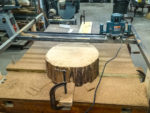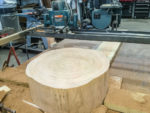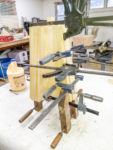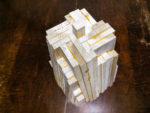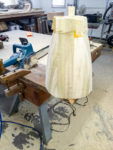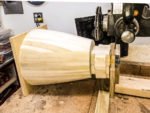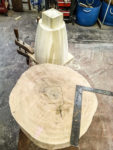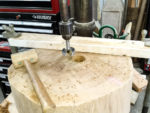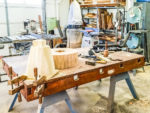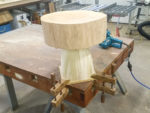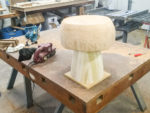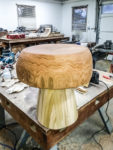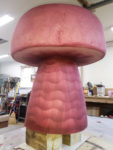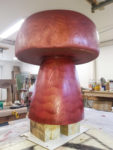I’ve had a short section of a log in my possession for years. I have no idea where it came from, or what type of wood it is, just that it’s very light in weight. It’s also light in color, yet it produces dark brown chips. It’s a mystery.
Nonetheless, I feel it was destined to become something. I figured it would work quite happily as a stool, perhaps or a low table. Maybe both.
- 1
I started working without a plan. No drawing or sketching. The round still had bark on it that seemed tight and stable. My initial thinking was to keep it, but a small funky patch led to removing it completely.
The one notion I was committed to was that it should be shaped freehand- not turned or milled with mechanical precision. The exception to that was that I wanted a top flat enough to serve as a tabletop.
The photos illustrate the transition from point A to point A’. (Point B is an elusive destination, sometimes nothing more than a mirage.)
The sequence begins with dressing the ends of the mystery log flat and parallel to each other. This operation caused me to finally come up with the ‘router sled’ apparatus seen in the photo. The next few images show the base being assembled out of forty-five pieces of poplar, then being rough shaped, and finally having its tenon milled on the radial arm saw.
The top and base are introduced to one another in one photo. The top isn’t round, so finding its ‘centroid’ required a loop of string, a pencil and a loose, relaxed attitude. The corresponding mortise followed soon thereafter.
There is a photo showing the unfinished stool sitting in a living room typical of 21st century America. By the absence of robotic assembly lines and uniformed personnel, we might infer that this was taken at a private residence.
The photo that I think is the most interesting shows a close-up of the stool with the grain of the wood standing out.
In this shot, the stool had been wiped with a water-dampened rag to get a preview of the way it might look after finishing. Previewing in this manner informs the choice of finishing technique and material. When the wood is something common, like oak or pine, you have some idea of what to expect when applying a given finish. Typically, there would also be some scraps of that wood available to experiment with. In this case, though, I didn’t have a clue.
The wetting process revealed a large difference in the grain and color of the top and that of the poplar base. If I had started with any sort of plan, I may have chosen a different wood for the base, but what that choice would have been still isn’t clear. I had the poplar, and anyway, I wasn’t sure where this project was going to lead. Indeed, until I wetted the project with water, I didn’t even realize that crazy pattern of grain existed.
As it turned out, the the differences in the top and base, both color and pattern, were simply too jarring to accept. This ultimately led to developing a finish that obscured some the grain to a degree. (Note the ‘scallop’ effect given to the base.) The trial and error continued, with error prevailing at every turn, right up to the end. After getting the color and transparency of the stain figured out, I tried using a water-based clear finish. Try as I might, I couldn’t conquer a stubborn fisheye problem seeming to come from the very pores of this mystery wood, and I wound up sanding it all back to zero, A proper oil-based finish finally won the day.
I suppose I could limit my activities to tried-and-true endeavors using only familiar materials, but I doubt that I’d bother to do that for very long.

